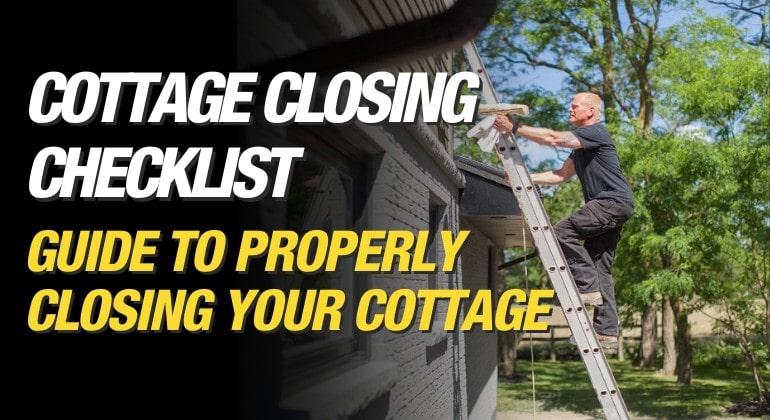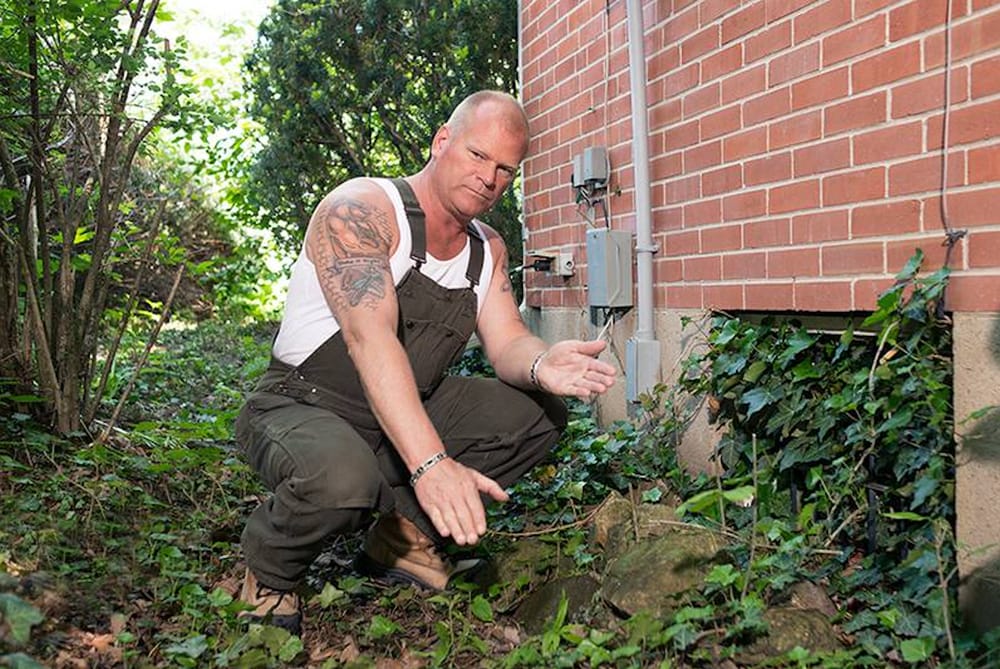When it comes to homes, water is enemy number one, and these 3 exterior home maintenance tasks will help prevent water damage. Water damage is one of the most costly...

Complete Cottage Closing Checklist: Guide To Properly Closing Your Cottage
By Mike Holmes
Mike’s Advice / Home Safety & Maintenance
Wednesday, September 13th, 2023 @ 5:33pm
8 To-Do Lists on How to Close a Cottage for the Winter
The one thing I’m always aware of is how quickly time flies by. I feel like we just started summer, but soon we will be saying goodbye to the nice warm weather and hello to winter. For many, this also means saying goodbye to the cottage and shuttering it up for the winter. Now, I know it’s not officially fall yet, but it’s good to go over some of the essential cottage closing checklist items so you’re prepared when the time comes.
Tip #1 – Pack Up and Clean:
The first thing I recommend is to pack up essentials and safely store things away. Having a well-organized garage can make all the difference during this process.
It’s important to create a safe, secure, and well-organized location for all of your seasonal accessories, gear, and equipment. Having a good and efficient garage organization system is a big part of that. Also consider overhead racks, wall, and ceiling shelves, as well as wall and floor cabinets to make the most of the space.

Garage cabinets with workbench installed for Angela’s project so she can work on her motorcycle and store all her tools.
RELATED:
It’s also important to properly store your outdoor furniture. If you can’t store furniture inside or in a crawl space ensure it is covered and secure using straps or bungee cords.
Doing a final cleaning never hurts. It actually makes things easier when the time comes to reopen your cottage again.
Pro Tip:
Ensure you are up to date on all the insurance for your cottage. We live in a time filled with lots of natural disasters. Unfortunately, I can’t imagine the damage that’s happened all over the world this year alone. Having good insurance in place can save you the headache if anything were to happen.
Store Liquids Properly that Can’t Handle the Cold:
Some liquids, like paint, may be better stored at home in the garage or the basement, while gas for the boat or other machines can be stored in the boathouse or a tool shed.
Tip #2 – Check the Roof
If you keep an eye on things regularly then you’ll know that doing a roof check at the end of the season is a good idea.
The further north and remote your cottage is, the more snow you will likely get – this means the roof of your cottage can take a beating. Too much snow can cause the roof to buckle.
Make sure your roof isn’t showing signs of stress or damage. If you do, get it inspected now so you still have time to get it taken care of before the snow arrives.
Some factors to consider when picking your shingles include:
- Limited Lifetime Warranty
- Style
- Colour
- Features
- Size
READ MORE:
The Ultimate Guide to Choosing the Best Roofing Shingles
BONUS TIP:
If you see snow on your roof, that’s actually a good thing because it means your insulation is doing its job.
It’s possible for the snow to melt when heat leaks from your roof. This will then refreeze at a cold point on your roof, leading to dangerous ice dams. When that occurs, water can ultimately start to back up into your home and begin to do some major damage.

I’m a big fan of using an ice and water shield – all over a roof, as a secondary membrane to prevent ice dams.
Tip #3 – Fireplace & Chimney
Examine the fireplace and chimney to get your cottage ready for the winter. Make sure the damper and flue work properly. I also recommend scheduling a chimney sweep to remove soot and other debris.
Make sure to also check for damage and cracks to stop heat and smoke leaks. If there are any cracks it’s best to get them repaired as soon as you can to avoid any damage due to water penetration later on.
If you have a fireplace, get it inspected and cleaned out at the end of the season and close the damper vent.
You can also install detectors, seal the damper, and use a fireplace cover to avoid any rodents or critters from getting in.
READ MORE:
Keep Critters Out
To prevent unwanted visitors, like raccoons, squirrels, and other critters, ensure your chimney is capped. For smaller animals like mice, fill in any gaps or cracks that could be a potential entry point. That includes gaps around exhaust pipes.
Remember mice can squeeze into a very tiny space. To fill the gaps, use low-expansion foam. This is a great product for exterior and interior applications and is easy to use. We’ve used it on many of our projects. Once you’ve applied the foam, seal around it with exterior caulking to make it watertight.
READ MORE:
Tip #4 – Clean Your Gutters
The final thing that needs to be done on your roof is to ensure your gutters are clear of debris and leaves.
Blocked gutters can cause water to back up toward the roof, get under the shingles, and damage the roof sheathing and structure. You also don’t want to experience any ice damming.
Don’t forget to inspect the gutter extensions for damage, and make sure they are directed several feet away from the foundation of the cottage.
Tip #5 – Prune Trees
Make sure the trees close to the cottage are pruned sufficiently and that branches are a safe distance from any overhead power lines. Evergreen branches hang lower with snow on them so keep that in mind too. If you have concerns, arrange to get an arborist or tree removal specialist to assess any concerns you may have before the winter.
Before starting to prune vegetation within 10m of powerlines, first, check with your local utility company to verify the ownership. If you own the hydro poles, make sure to make the needed arrangements to have them shut off before any work begins.
Tip #6 – Septic Systems
Most cottages will likely have a septic system that needs to be regularly serviced every three to five years depending on the usage. If you don’t keep a log (which I highly advise), then you might want to consider scheduling a checkup before you close the cottage.

Resist the urge. There really shouldn’t be anything on your septic system.
READ MORE:
Keeping Your Septic System In Top Shape To Manage Waste Water
Tip #7 – Electrical Safety
Preparing your cottage’s electrical system for the winter season can help create a safer and smoother reopening in the spring.
Clean and Unplug Major Appliances
Empty and defrost your fridge and freezer to avoid any rotting or mold. Also, leave the doors ajar to prevent mildew and allow for airflow. Unplug the microwave, washing machine, dryer, and stove.
Properly Store Extension Cords:
It is recommended that you store all extension cords in a rodent-proof container. I also recommend taking them home to be stored in your basement or garage, because extreme temperatures cause extension cords to become brittle and crack.
If you are leaving the Electricity On
Go to each room and unplug any unnecessary electrical devices. This will reduce the effects of “phantom power”. It is also recommended to turn off the power supply to major appliances at the main panel.
Replace any batteries to ensure they will continue to work throughout the winter season. Leaving the power on to essential devices is a good idea, like smoke detectors, exterior lights or security systems.
Consider smart systems that can be connected to your cottage’s Wi-Fi. These let you monitor your cottage for floods, freezing and fire, as well as control security lighting and the thermostat all from the comfort of your city home. You can also consider a camera system to monitor both property security to give you that peace of mind.
If you are turning the Electricity Off
It’s important to preserve your home’s energy efficiency and the safety of your cottage while you’re away for the winter. This step decreases standby power usage, sometimes known as “phantom” power. Even after being switched off, a lot of gadgets continue to use very little quantities of electricity. Over time this can pile up and result in greater energy costs.
You can prevent this energy drain and reduce your environmental impact by disconnecting them and turning off the main power switch.
This reduces the possibility of electrical fires or damage from power surges occurring while you are away.
Important Tip:
If you still have a fuse panel, be sure to unplug and switch off all appliances and electrical devices before you switch off the main power.
Tip #8 – Water Shut-Off
On the last day of closing up the cottage shut off the main water supply and drain the pipes. To ensure there is no water in the lines, turn one of your taps on to make sure the water has fully drained. Then shut it off.
If your cottage is not winterized, I recommend you wrap your pipes as added protection against frost and possible leaks.
Drain Your Water Tank
Turn off the power supply before draining your hot water tank to avoid damaging the heating element.
We still have a bit of summer left, but get a head start on some of these things before it’s too late. It will make closing the cottage a lot easier and the opening next spring easier too!
READ MORE:
Indoor Fall House Maintenance Checklist







